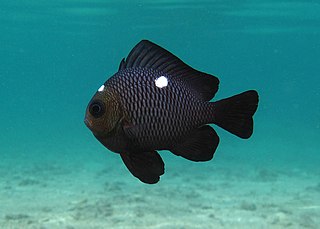
Ovalipes ocellatus, known as the lady crab, is a species of crab from eastern North America. Other names for it include the leopard crab or Atlantic leopard crab due to the leopard-like rosette patterns on its shell, the calico crab, or ocellated crab. It has a shell 3 in (7.6 cm) long and only slightly wider, which is covered in clusters of purple spots. It occurs from Canada to Georgia, and lives mainly on molluscs, such as the Atlantic surf clam.

Heteractis magnifica, also known by the common names magnificent sea anemone or Ritteri anemone, is a species of sea anemone belonging to the Stichodactylidae family native to the Indo-Pacific area.

Ovalipes is a genus of crabs in the family Ovalipidae.

Ovalipes catharus, commonly known as the paddle crab, swimming crab, or Māori: pāpaka, is a species of crab in the family Ovalipidae. They are found in shallow, sandy-bottomed waters around the coasts of New Zealand, the Chatham Islands, and uncommonly in southern Australia. They are opportunistic, aggressive, and versatile feeders active mostly at night, preying predominantly on molluscs and crustaceans. They are also highly prone to cannibalism, which comprises over a quarter of their diet in some locations. Their paddle-shaped rear legs and streamlined carapace allow them to swim rapidly to capture prey and to burrow in the sand in order to escape predation. Their mating season is in winter and spring; the male carries the female until she moults, after which the two mate and the female likely moves into deeper waters to incubate and disperse her larvae.

The threespot dascyllus, also known as the domino damsel or simply domino, is a species of damselfish from the family Pomacentridae. It is native to the Indo-Pacific from the Red Sea and East Africa, to the Pitcairn Islands, southern Japan, and Australia, and can also be found in some parts of the Philippines. Its grey to black body has two lateral white spots and one between the eyes like domino hence the name; the threespot dascyllus grows up to 13 cm (5.1 in) in length. Coloration is somewhat variable; the spot on the forehead may be absent and the lateral spots very much reduced. It feeds on algae, copepods and other planktonic crustaceans.
Giacomo Bernardi is a Professor of Ecology and Evolutionary Biology at University of California Santa Cruz. He earned his B.A., M.S., and Ph.D. at the University of Paris and did post-doctoral work from 1991 to 1994 at Hopkins Marine Station at Stanford University.

Leptus is a genus of large mites belonging to the family Erythraeidae; they resemble members of the related genus Balaustium, but can be distinguished by the eyes, which in Leptus species are set much further forward on the body than in Balaustium species.

The flat-faced seahorse, longnose seahorse, low-crowned seahorse or three-spot seahorse is a species of fish in the family Syngnathidae. It is found in Australia, Cocos (Keeling) Islands, French Polynesia, Hong Kong, India, Indonesia, Japan, the Philippines, Singapore, Taiwan, Thailand, and Vietnam. Its natural habitat is shallow seas. It is threatened by habitat loss.

Ovalipes australiensis, commonly known as the sand crab or the surf crab, is a species of crab in the family Ovalipidae. Its range extends from Western Australia to Queensland, including Tasmania. It is fished commercially.

Stichodactyla gigantea, commonly known as the giant carpet anemone, is a species of sea anemone that lives in the Indo-Pacific area. It can be kept in an aquarium but is a very challenging species to keep alive and healthy for more than 3–5 years.

Apolemichthys xanthurus, the Indian yellowtail angelfish, is a species of marine angelfish belonging to the family Pomacanthidae. Other common names include cream angelfish, smoke angelfish, and yellowtail black angelfish. It is found in the Indian Ocean.

Cryptodendrum is a genus of sea anemones in the family Thalassianthidae. It is monotypic with a single species, Cryptodendrum adhaesivum, also commonly known as the adhesive anemone, pizza anemone, and nap-edged anemone. Like all symbiotic anemones it hosts zooxanthellae, symbiotic algae that help feed their host.

Pristicon trimaculatus, also known as the three-spot cardinalfish, is a nocturnal fish that lives in the Western Pacific Ocean, living around inshore coral reefs in waters around the Ryukyu Islands and Western Australia and the southern Great Barrier Reef, east to Samoa and the Marshall Islands. This species is uncommon. Juveniles have intense, dark markings on a light background, while adults' markings are dusky. Like other cardinalfish, they brood their eggs inside their mouths.
Neocentropogon is a poorly known genus of marine ray-finned fishes, waspfishes belonging to the subfamily Tetraroginae, which is classified as part of the family Scorpaenidae, the scorpionfishes and their relatives. The fishes in this genus are native to the Indian Ocean and the western Pacific Ocean.
Bathycongrus trimaculatus is an eel in the family Congridae. It was described by Emma Stanislavovna Karmovskaya and David G. Smith in 2008. It is a tropical, marine eel which is known from the southwestern Pacific Ocean, including Fiji, New Caledonia, and the Solomon Islands. It dwells at a depth range of 357–550 metres. Males can reach a maximum total length of 16.1 centimetres.

Apolemichthys trimaculatus, the threespot angelfish or flagfin angelfish, is a demersal marine ray-finned fish, a marine angelfish belonging to the family Pomacanthidae. It has a wide Indo-Pacific distribution.

Tabanus trimaculatus is a species of horse fly in the family Tabanidae.

Habronattus trimaculatus is a species of jumping spider. It is found only in peninsular Florida in the United States.

Ovalipidae is a family of crabs in the family Portunoidea. These were formerly members of the family Portunidae. It contains only the genus Ovalipes.















